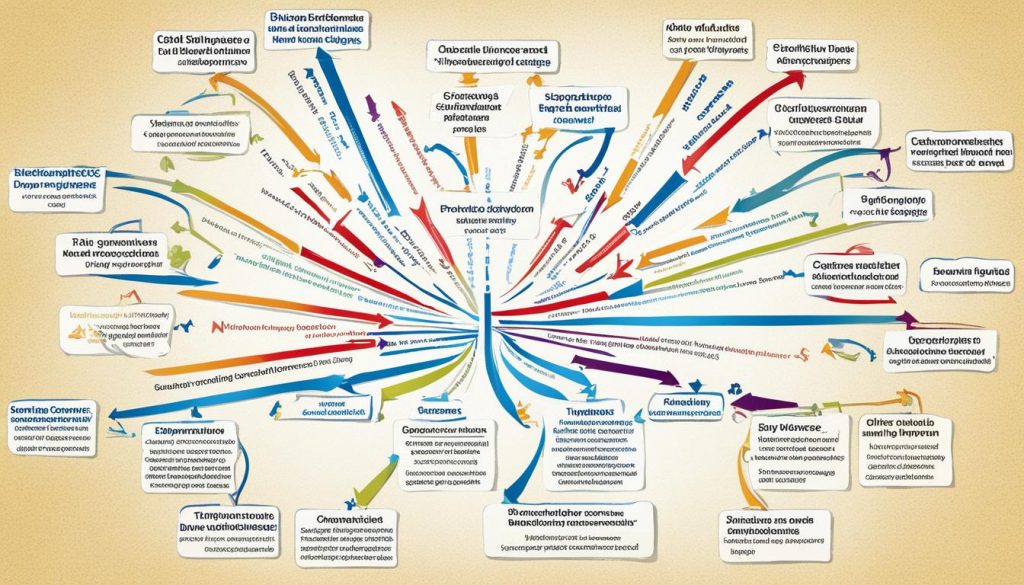Divorce can be a complex and emotionally challenging process. If you find yourself in this situation in North County San Diego, it’s essential to understand the legal requirements and available options. Whether you need a divorce attorney or a family law attorney, expert counsel can help you navigate through the complexities and ensure a fair resolution.
Key Takeaways:
- Residency requirements in California: To file for divorce, you must be a resident of California for at least six months and a resident of the county where you’re filing for the past three months.
- Types of divorce and separation: California offers various options, including no-fault divorce, uncontested divorce, contested divorce, legal separation, summary dissolution, annulment, and domestic partnership termination.
- Child custody, support, and visitation: California prioritizes the child’s best interests when making decisions related to custody, support, and visitation.
- Property division: In California, property division follows community property laws, where assets and debts acquired during the marriage are divided equally.
- Filing and serving divorce papers: Initiating a divorce involves filling out specific court forms, filing them at the local courthouse, and serving them to your spouse.
California Divorce Requirements
To file for divorce in California, individuals must meet specific requirements. One must be a resident of the state for at least six months and a resident of the county where they are filing for the past three months. These residency requirements ensure that individuals seeking a divorce have a connection to the state and can access its legal system.
Filing for divorce involves initiating a court case by completing and submitting specific forms to the county court. It is essential to meet these requirements to proceed with the divorce process in California.
“Meeting the residency requirements is crucial when filing for a divorce in California. The state requires that you have been a resident for at least six months before initiating the process. Additionally, you must have lived in the county where you are filing for the past three months. These requirements ensure that you have a substantial connection to the state and allow you to access its legal system effectively.”
Types of Divorce and Separation in California
When it comes to ending a marriage in California, couples have several options to choose from depending on their unique circumstances. Understanding the different types of divorce and separation available can help individuals make informed decisions about their futures.
No-Fault Divorce
No-fault divorce is recognized in California, allowing individuals to obtain a divorce even if their spouse does not agree to it. This option eliminates the need to prove fault or assign blame, simplifying the process and potentially reducing conflict.
Uncontested Divorce
In cases where both spouses agree on key issues such as property division, child custody, support, and finances, an uncontested divorce can be a quicker and easier process. It involves cooperation and compromise, allowing couples to move forward amicably.
Contested Divorce
When spouses cannot reach an agreement on one or more issues, a contested divorce may be necessary. This type of divorce can be more complex and time-consuming, often requiring mediation, arbitration, or even court trial to resolve disputes.
Legal Separation
Legal separation provides an alternative to divorce for couples who wish to live separately and divide their assets and debts without officially ending their marriage. It allows individuals to address key issues while providing temporary legal protection.
Summary Dissolution
Summary dissolution is a simplified divorce process available to couples who have been married for a short period, have no children, and possess minimal assets and debts. It offers an expedited and streamlined route to ending the marriage.
Annulment
If a marriage was not legally valid due to fraud, bigamy, or force, an annulment may be an option. Annulment declares the marriage null and void, as if it never took place, but specific grounds must be met to qualify for this type of dissolution.
Domestic Partnership Termination
For registered domestic partners in California who wish to end their partnership, domestic partnership termination provides the necessary legal process. It allows for the dissolution of the partnership while addressing key issues similar to divorce cases.
Understanding the options available is crucial for individuals seeking to navigate the divorce process in California. Whether opting for a no-fault divorce, pursuing an uncontested or contested path, or exploring other alternatives like legal separation, summary dissolution, annulment, or domestic partnership termination, couples can choose the approach that best suits their needs and circumstances.

Child Custody, Support, and Visitation in California
In California, the well-being of children takes center stage when determining child custody, support, and visitation arrangements. The state recognizes that both parents have equal rights to custody, ensuring a fair process for all parties involved. In cases where one parent is unable to fulfill their custodial responsibilities or has abandoned the child, the other parent can seek sole custody in the child’s best interests.
When it comes to child custody in California, there are two types: legal custody and physical custody. Legal custody grants parents the authority to make important decisions regarding the child’s welfare, including matters of health and education. On the other hand, physical custody determines where the child primarily resides.
Child support is an essential aspect of ensuring a child’s well-being. In California, child support is calculated using a state formula that takes into account the parents’ incomes, the amount of time spent with the child, and other relevant factors. This calculation serves to cover the child’s basic needs and ensure financial stability.
Visitation rights are granted to the parent who spends less than half the time with the child. This provides them with meaningful and regular contact with their child. However, visitation may be restricted or denied if it is deemed to be detrimental to the child’s overall well-being.

In ensuring the best outcomes for children, California law prioritizes their needs and interests in matters of custody, support, and visitation. By considering the child’s well-being at all stages, the state aims to promote healthy and stable relationships between parents and their children.
Property Division in California
In California, property division follows community property laws, ensuring a fair distribution of assets and debts acquired during the marriage. Community property includes property, income, retirement benefits, and debts earned or acquired during the marriage by either spouse, regardless of which spouse’s name is on the title or account.
**Community property** in California means that these assets and debts are considered jointly owned by both spouses and, upon divorce, are divided equally between them. It is irrelevant if one spouse did not contribute financially to the acquisition of the property.
As per California law, **separate property** is not subject to division. Separate property comprises assets or debts acquired by either spouse before the marriage, after the separation, or through gifts or inheritances received individually during the marriage. These individual assets or debts remain with the respective spouse and are not subject to equal division.
To illustrate the concept of property division, consider the following example:
James and Sarah have been married for ten years. During the marriage, they purchased a house using James’s income, although the house is solely titled in Sarah’s name. In the event of a divorce, the house is considered community property and will be divided equally between James and Sarah, despite the title being in Sarah’s name.
In addition to property division, California courts also consider the issue of alimony or spousal support. Temporary spousal support may be awarded during the divorce process to ensure the lower-earning spouse can maintain their living standards. Long-term spousal support may be granted to provide financial assistance until the lower-earning spouse becomes self-sufficient. The duration of spousal support varies based on individual circumstances and may last for approximately half the length of the marriage.
Examples of Property Division in California
| Assets | Classification | Division |
|---|---|---|
| A jointly-owned house | Community Property | Equal Division |
| James’s retirement account | Community Property | Equal Division |
| Sarah’s inheritance from her grandmother | Separate Property | Belongs to Sarah |
| Debts acquired during the marriage | Community Property | Equal Division |
It’s important to note that property division can be a complex process, and it’s advisable to seek legal counsel from a qualified attorney to ensure the fair and equitable division of assets and debts.

Filing and Serving Your Divorce Papers
When initiating a divorce or legal separation in California, it is important to understand the process of filing and serving divorce papers. This section will guide you through the necessary steps to ensure a smooth transition.
To begin the process, you will need to fill out specific court forms, including the Petition (Form FL-100) and the Summons (Form FL-110). Additional forms may be required for cases involving children or spousal support. These forms can be obtained from the California Courts website or your local courthouse.

After completing the necessary forms, you will need to file them at the local courthouse. This can be done in person, by mail, or through e-filing, depending on the options available in your county. It is essential to ensure that all required forms are accurately filled out and submitted.
When filing for divorce in California, there are fees associated with the process. Filing fees typically range from $435 to $450. However, if you are facing financial challenges, you can apply for a fee waiver to alleviate the financial burden.
Once the documents have been filed, they must be served to your spouse. It is important to note that the person serving the papers must be an adult other than the filer. This step ensures that the spouse receives the necessary legal documents.
To verify that the spouse has received the divorce papers, the individual serving the documents completes a Proof of Service form (FL-115). This form serves as proof that the papers were properly delivered to the spouse.
Completing the filing and serving process accurately and efficiently is crucial to move forward with your divorce or legal separation. Seek guidance from a reliable attorney or legal professional to ensure that all the necessary steps are taken correctly.
Conclusion
Navigating the divorce process in North County San Diego requires a comprehensive understanding of California’s divorce requirements, the various types of divorce and separation available, child custody and support laws, property division rules, and the process of filing and serving divorce documents. It can be a complex and emotionally challenging journey.
However, seeking expert legal support from a knowledgeable divorce attorney or lawyer can provide individuals with the guidance and representation they need to navigate the complexities of divorce with confidence. A skilled attorney can help explain the options, advocate for their clients’ rights, and work towards a fair resolution.
By understanding the available options and following the necessary steps, individuals can proceed through the divorce process in North County San Diego with clarity and a solid support system. With the right legal support, individuals can aim for a resolution that prioritizes their best interests and the well-being of their family.




No comments! Be the first commenter?